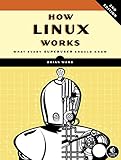All Categories








About Linux Assembly Language Programming
Product Description *Master x86 assembly language from a Linux perspective! *Essential information for creating Linux device drivers *How Linux works under the hood! *CD-ROM includes edlinas, the no.1 Linux x86 hands-on assembler development simulator The first Linux-centered guide to x86 assembly language! In Linux Assembly Language Programming, Bob Neveln explains all the key features of x86 assembly language in the context of the Linux operating system and the C language. The books step-by-step, one-concept-at-a-time coverage will help any hardware programmer move to Linux, and master essential skills for Linux device driver development. You wont just learn new x86 assembly language skills: youll also gain powerful under the hood insight into how Linux works. Bonus CD-ROM includes edlinas, the no.1 Linux-based x86 interactive assembler development simulator! Linux x86 assembly language programming, from start to finish! *Place-holding numeration *Logic circuits *Computation *The four-field format *Machine language *Memory *The stack *Linux user programs *NASM *DOS programs *Interrupts *Bit manipulations *Device drivers *And more... From the Inside Flap Preface Assembly language is language which gives the programmer direct control over the computer. That is what appeals to people about assembly language. It is like using a stick shift. Programming with other languages, high-level languages, is like using an automatic. Many people who use computers simply run programs. To them a program is a canned software package. People who like to write programs like to be able to shape the behavior of the machine the way metalsmiths shape metal into useful mechanical tools. Amongst all the programs on a computer, there is one program which runs the machine: the operating system. It controls everything. It offers "services" to the other programs. Most operating systems force programmers to leave their programming skills behind as they approach the operating system and to use it as they would a canned software package. That is because its source code is a secret. Linux portends the end of secret code in computing. Because the Linux source code and a compiler for it are right there on the computer along with the other source code, it allows programmers to work with the operating system as they do with programs they have written. Operating systems were once written by programmers employed by computer manufacturers. Revolutions in hardware produced corresponding revolutions in the software. When Linus Torvalds rewrote Linux so that it would run on the Alpha architecture, his goal was not to increase its hardware base from one platform to two, but to make Linux platform-independent. The subsequent ports of Linux, to everything from a Sparc to a PowerPC, demonstrate the success of his rewrite. The chief value of it is that it provides us with confidence that Linux is here to stay. We don't have to fear a PowerPC revolution coming along and forcing us to dump all of our old software. Assembly code, on the other hand, is intrinsically platform-dependent and is justifiably regarded with caution for just this reason. It will have to be redone when the next hardware revolution takes place. Furthermore, people who compare the machine language of the 386 with other machine languages, both real and ideal, inevitably end up regarding the 386 language as a historical accident. On the other hand, the genetic code is sometimes referred to as a frozen accident. The term is based on the idea that the genetic code ceased its evolution when the number of proteins whose code would be "broken" by a mutation in the genetic code became so large that such mutations became lethal, and so the code became fixed. It remains to be seen whether 386 machine code has been "frozen" into place by the size of its software base. The threat of a PowerPC revolution has passed. On the other hand, many Linux enthusiasts anticipate an Alpha revolution. But the Alp



























